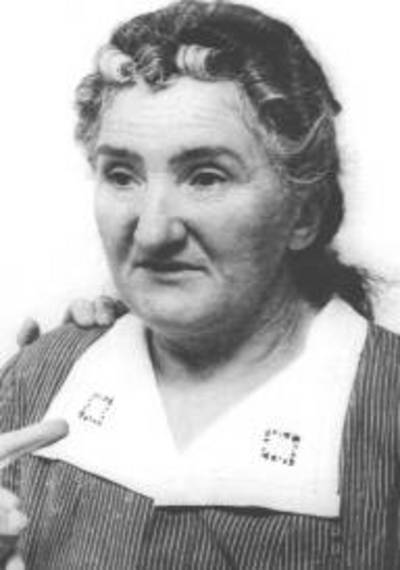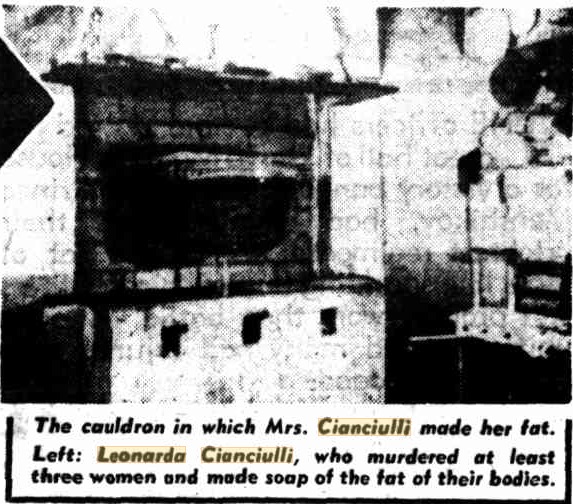
Named the Soap Maker of Correggio, Leonarda Cianciulli was known for killing three women and turning them into soap and sweet treats. While her crime was unusual, what was truly fascinating about Leonarda’s case was her past. Looking back, we can plainly see what drove her to commit the murders and her reasoning was clear. She was a mother who would do anything to protect her children.

The Backstory
To get an idea of what made Leonarda Cianciulli a killer, we must first look at her life before she committed the murders. By all accounts, she was melancholic and had attempted to kill herself two times as a child.
From her family’s home, she went straight into marriage and married a man her parents disapproved of. Her parents had wanted an arranged marriage for her and her choosing a husband on her own happened against their wishes.
There must have been a lot of other tension between Leonarda and her mother because Leonarda believed that her mother had cursed her as a parting gift.
To top it all off, Leonarda was also very superstitious and claimed that two fortunetellers predicted that all the children she would have would die. She had 17 children and lost 13 of them.
With only 4 children left, she visited a fortune teller again to see if her future looked any better. She was warned that it was still grim. [SOURCES 1 and 2]
The Final Straw
Leonarda’s final push over the edge happened when her eldest son, Giuseppe Cianciulli, prepared to leave home and fight for the Italian army. It was WWII and mothers all over the world feared for the lives of their sons.
Leonarda felt a strong need to do something that would protect her son. She prayed, but it didn’t feel like it was enough. Prayer wasn’t the solution to combat the deadly curse that had been placed on her and her children.
In Leonarda’s mind, it came down to a life for a life. Only a human sacrifice would work to protect her son and remaining children from death. [SOURCE 1]
Her Supernatural Talents
Not surprisingly, Leonarda practiced fortune telling. This was Italy, after all, and the home of some of the strongest superstitious beliefs in more recent times. She was known to give readings for neighbors, which was possibly how she was able to lure her three victims into her home.
It was also believed that she was able to hypnotize people and that she could soothe any suspicions her victims might normally have when things didn’t feel right. She was, after all, able to murder all three women without them putting up any sort of fight. [SOURCE 3]
First Victim
Faustina Setti, age 73, wanted nothing more than to get a husband. Faustina became friends with Leonarda because she was able to read the cards and see into the future for her.
Knowing full well that she was going to sacrifice Faustina, she read the cards for her one day towards the end of 1939 and told her that she would soon be wed. Leonarda created a story about a wealthy gentleman in a nearby village who wished to marry a woman to spend his remaining years with.
Faustina was undoubtedly excited. She dyed her hair blonde and sold her home along with her unnecessary possessions in preparation to meet and marry the fictitious man. She met up with Leonarda to thank her for her kindness and sat to have a cup of drugged coffee.
Over their coffee, Leonarda had Faustina write up letters to her friends. When the letters were done, Leonarda hit her from behind with a hatchet. [SOURCE 3]
Second Victim
Francesca Soavi, age 55, lived alone. She was looking for employment and went to Leonarda for help. Amazingly, Leonarda said she could get Francesca a position at a school in Piacenza.
It didn’t take much convincing to get Francesca to sell off all her stuff to prepare for her move. Leonarda said she had taken care of everything else for her new life working at the school.
On September 5, 1940, Francesca visited Leonarda to say farewell. During her visit, Leonarda convinced Francesca to write two postcards to be sent to her friends. When she was finished with her postcards and after drinking drugged wine, Leonarda killed Francesca with a hatchet, the same as she had done to her first victim. [SOURCES 3 and 4]
Third Victim
Leonarda’s third victim led to her undoing. Virginia Cacioppo, age 53, was a former soprano singer. Bored with living in a village, Virginia heard the big city call. Virginia and Leonarda became friends and, knowing what Virginia wanted most in life, Leonarda told her that she had gotten her a job in a city factory. The only thing Leonarda asked was that Virginia not tell anyone that she had made the arrangements. Leonarda didn’t want any known ties between herself and Virginia.
Virginia, of course, couldn’t keep her mouth shut and told three of her friends about the arrangement Leonarda had made for her.
Virginia’s end happened pretty much the same as the first two victims. On September 30, 1940, she was poisoned and then struck with a hatchet. [SOURCE 3]

What Was Done With The Bodies
How does one get rid of three bodies? Not wanting things to go to waste, Leonarda made use of the fat and blood. After she killed Faustina, she removed the victim’s clothing and used a saw and a knife to cut her into nine pieces. The blood had been drained into a basin and, after it coagulated, Leonarda used it to make chocolates which she gave away to her friends. The remains were cooked down and the fat was used to make soap and candles.
Francesca was undressed, chopped, and made into soap.
Virginia was also murdered in the kitchen, the same as the previous two. She was a large woman and from her fat Leonarda was able to make lightly perfumed soap and candles. [SOURCE 3]
During Leonarda’s trial, she proudly told her lawyers that she donated the copper kettle used to cook down her victims to the war effort. [SOURCE 5]
Suspicions
While it seemed that Leonarda was doing everything in her power to cover up her murders, she made a few vital mistake. First, there was Virginia. Virginia did not keep her secret and blabbed to her friends about the job Leonarda arranged for her.
Leonarda also took the money, jewelry, and clothing from her victims. She gave some of the jewelry away as a gift, and that linked her again to Virginia. Virginia’s clothing was also found in her home.
Leonarda had managed to get a large sum of money from her victims because she had instructed them to sell their homes and unnecessary belongings. With so much money, Leonarda began to spend it a bit too freely and tongues, no doubt, began to wag.
There was also a neighbor who liked to keep watch on what everyone was doing. The neighbor had seen Virginia enter Leonarda’s house, but she never left.
The final nail struck when Virginia’s sister-in-law grew suspicious about Leonarda and went to the superintendent of police. An investigation was launched. [SOURCES 3 and 4]
Her Son’s Help
Given the times, the police did not believe that a woman could commit the murders and dissection all by herself. They turned to her eldest son, Giuseppe Cianciulli, and arrested him as an accomplice.
When Leonarda learned of her son’s arrest, she confessed to having done everything on her own. The only thing her son did was take the bones and other unwanted bits to the river to dump them. The remains were wrapped in paper to prevent him from knowing exactly what they were. She also had him send out the letters the victims had written so that no one would suspect that they were gone from this earth. Her son was merely following his mother’s instructions.
To prove that she was able to cut up a body on her own, judges, police, and doctors took her to the morgue and let her dissect a corpse. To their amazement, Leonarda was able to cut up the corpse into nine pieces in twelve minutes. [SOURCE 3]
Sentencing
There was no doubt of her guilt. She had not only confessed to the murders, but plenty of evidence was found in her home to confirm her confession.
At her trial, Leonarda was determined to be either medically sane or partially insane, depending on which doctor examined her. In light of the lack of a definitive diagnosis, Leonarda was sentenced to thirty years in prison and to three years in a criminal asylum.
While in prison, she wrote her memoirs, describing her childhood and her life events. It is said that her eldest son did not believe she was a murderess until after he had read her memoir.
On October 15, 1970, Leonarda passed away at the ripe old age of 76. She died of cerebral apoplexy while she was serving her time in a women’s criminal asylum. [SOURCES 3 and 4]

